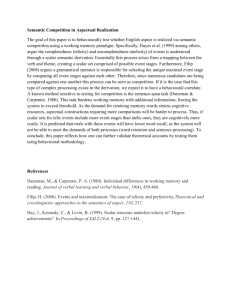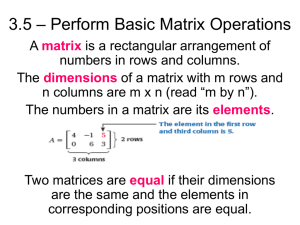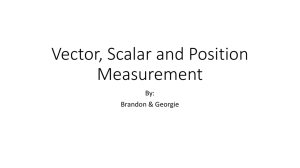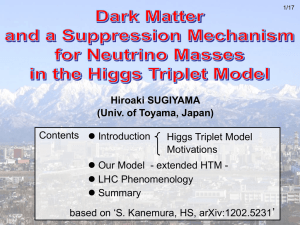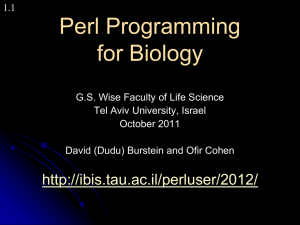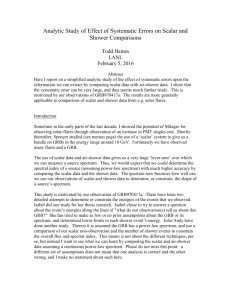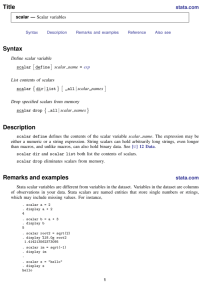Scalars 2013
advertisement
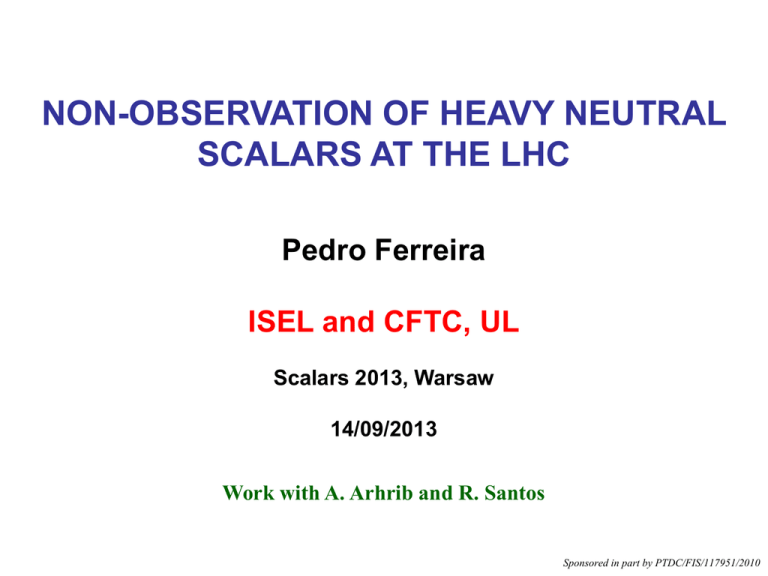
NON-OBSERVATION OF HEAVY NEUTRAL SCALARS AT THE LHC Pedro Ferreira ISEL and CFTC, UL Scalars 2013, Warsaw 14/09/2013 Work with A. Arhrib and R. Santos Sponsored in part by PTDC/FIS/117951/2010 • LHC discovered a new particle (a scalar?) with mass ~125 GeV. • Up to now, all is compatible with the Standard Model (SM) scalar particle. See yesterday’s talks by K. Moenig and G. Tonelli. BORING! (not the talks…) Two Higgs Dublet model, 2HDM (Lee, 1973) : one of the easiest extensions of the SM, with a richer scalar sector. Can help explain the matter-antimatter asymmetry of the universe, provide dark matter candidates, … G.C. Branco, P.M. Ferreira, L. Lavoura, M. Rebelo, R. Santos, M. Sher, J.P Silva, Physics Reports 716, 1 (2012) TWO HIGGS DOUBLET MODELS • They are the simplest Standard Model extension – instead of a single scalar doublet, we have two, Φ1 and Φ2. • They do not affect the most successful predictions of the Standard Model. • They have a richer scalar particle spectrum. • They are included in more general models, such as the Supersymmetric one. • They allow for the possibility of minima with spontaneous breaking of CP... (T.D. Lee, Phys. Rev. D8 (1973) 1226) The Two-Higgs Doublet potential Most general SU(2) × U(1) scalar potential: m212, λ5, λ6 and λ7 complex - seemingly 14 independent real parameters Most frequently studied model: softly broken theory with a Z2 symmetry, Φ2 → -Φ2, meaning λ6, λ7 = 0. It avoids potentially large flavour-changing neutral currents. Softly broken Z2 potential • EIGHT real independent parameters. • The symmetry must be extended to the whole lagrangian, otherwise the model would not be renormalizable. Coupling to fermions MODEL I: Only Φ2 couples to fermions. MODEL II: Φ2 couples to up-quarks, Φ1 to down quarks and leptons. ... Scalar sector of the 2HDM is richer => more stuff to discover Two dublets => 4 neutral scalars (h, H, A) + 1 charged scalar (H±). h CP-even scalars H A - CP-odd scalar (pseudoscalar) h, H → γ γ h, H → ZZ, WW (real or off-shell) h, H → ff H → hh (if mH>2mh) … A→ γ γ A→ ZZ, WW A→ ff … Certain versions of the model provide a simple and natural candidate for Dark Matter – INERT MODEL, based on an unbroken discrete symmetry. Deshpande, Ma (1978); Ma (2006); Barbieri, Hall, Rychkov (2006); Honorez, Nezri, Oliver, Tytgat (2007) THEORETICAL BOUNDS ON 2SDM SCALAR PARAMETERS Potential has to be bounded from below: Theory must respect unitarity: EXPERIMENTAL BOUNDS ON 2HDM SCALAR PARAMETERS • Precision electroweak data (via the S, T, U parameters) constrain the scalar sector. • The charged scalar has potentially large contributions to B-physics phenomena –model II is very highly constrained ( m 340GeV ), model I H less so. The contraints involve also the value of tanβ, which determines the coupling of the charged scalar to the fermions. • ATLAS and CMS themselves have set new bounds on the mass/couplings of the heavier states (charged or neutral). • The observed rates of production × decay for the observed scalar relative to the SM further limits the allowed parameter space. • We will assume that the observed scalar is the lightest Higgs h! Maybe it isn’t the only possibility… • Generate random values for all potential’s parameters, such that mh = 125 GeV (all masses > 90 GeV, < 800 GeV, 1 < tan β < 30). NO BENCHMARKS, “blind” scan. • Ensure the potential obeys all theoretical constraints (unitarity, vacuum stability, etc.). • Impose current experimental bounds from electroweak precision data (S, T, U parameter bounds, B-physics data, etc.). • Calculate all branching ratios and production rates at the LHC. • Compare with ATLAS and CMS results. • Serve shaken, not stirred: • The 2HDM can fit the current LHC data as well as the SM. • That’s not entirely surprising – the 2HDM has a DECOUPLING LIMIT, in which it “reduces to the SM”. • 2HDM would be perfect to explain an eventual γγ excess – the model has one extra charged particle contributing for that loop decay, but which wouldn’t affect the gluon-gluon production, for instance. What we compare to data: Plenty of different production processes possible at the LHC: J. Baglio and A. Djouadi, JHEP 03 (2011) 055 VBF For searches for the heavier neutral states, we will have to consider the following ratios: Relative to a SM-like scalar, with mass equal to mH or mA. ATLAS and CMS already have a wealth of data on several channels for a wide range of masses. How much do they exclude? (see also C. Chen, S. Dawson, M. Sher, arXiv:1305.1624) HIGH MASS WW EXCLUSION In blue, without B-physics constraints. In green, with B-physics constraints. All Type-II points generated with mH+ > 360 GeV, so Bphysics constraints automatically satisfied. HIGH MASS ZZ EXCLUSION Quite a lot of parameter space points get excluded by these bounds… … but many more survive! All this is telling us is that H cannot couple very strongly to gauge bosons… … and that is to be expected: if h couples strongly to ZZ and WW, H must couple weakly: 2 2 ghVV gHVV 1 (probably need to worry a little about interference with background… Be conservative) HIGH MASS ττ EXCLUSION Not much happens for H – it is decaying mostly to ZZ and WW (and hh!) below ~350 GeV… … but A can be very sensitive to an improvement in these bounds! The reason is, below 350 GeV A “has nothing else to decay to” (except hZ!). LOW MASS γγ EXCLUSION Both in Type I and Type II, the di-photon channel doesn’t provide major exclusion for both H and A. All of these exclusions, combined, eliminate a Sizeable chunk of the 2HDM parameter space – but not enough to restrict the h rates, for instance. AND WHAT IF THESE HEAVY STATES ARE DECAYING MOSTLY TO OTHER STUFF?? H → hh A → Zh CRAZY IDEA: what if some of the h’s we’re observing at LHC are coming from the decays of the other heavy scalar states? There are new contributions to the lightest Higgs rates: This is the “usual” rate, which includes only “direct” production There are however “indirect” contributions as well: An H, an A or a H+ is produced first, and THEN decays to a light h – CHAIN HIGGS PRODUCTION. For instance, for H the new contribution would be given by With h’s produced in H decays”. being the “expectation value of Does it make any difference…? Manage to get larger values of RZZ, which couldn’t occur for Type I… Also for Rγγ. Plenty of Green points in the middle of blue ones => DIRECT + CHAIN PRODUCTION CAN YIELD PERFECTLY REASONABLE VALUES OF THE R’S! HOW IMPORTANT CAN CHAIN PRODUCTION BE? • Take all R’s of h within 20% of their SM values. • Consider the ratio between the DIRECT production cross section and the TOTAL. • This ratio is always > 75% => CHAIN PRODUCTION CAN BE UP TO 25% OF THE TOTAL PRODUCTION OF HIGGSES AT THE LHC. CONCLUSIONS • Non-observation of heavier scalars in 2HDM at the LHC imposes mild restrictions on the model. • Plenty of parameter space left to accomodate scalars with reasonable masses (> 130, < 600 GeV). • ττ rates in function of the masses might be able to put serious constraints on the model through the pseudoscalar expected rates. • Chain production of lightest scalars h possible and can amount to 25% of total h’s produced! • In that sense, we may already be observing H, A or H without realising ! • How do we test this? How do we disentangle chain production from direct one? How to concile chain production with observed gluon-gluon and VBF productions? Can chain production “mimic” direct production processes? • TO KNOW MORE… … READ OUR PAPER, IN THE ARCHIVE IN DAYS… Workshop on Multi-Higgs Models … AND COME TO LISBON IN ONE YEAR’S TIME! 2009 Lisbon, Portugal Workshop on Multi-Higgs Models 2012 Lisbon, Portugal Workshop on Multi-Higgs Models 2014 Lisbon, Portugal
